George Frederick Bristow: Symphony No. 4 in e minor, Op. 50, “Arcadian” (1872) – First movement: Emigrants Journey Across the Plains – An Analysis by Kyle Gann
Comments Off on George Frederick Bristow: Symphony No. 4 in e minor, Op. 50, “Arcadian” (1872) – First movement: Emigrants Journey Across the Plains – An Analysis by Kyle GannSeptember 8, 2019 by Admin
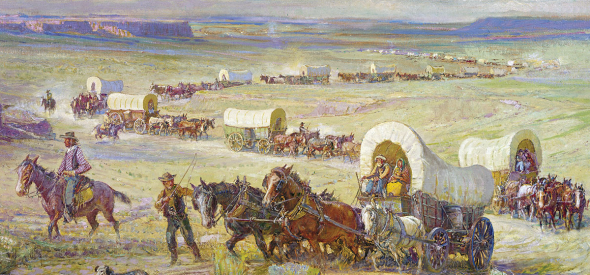
George Frederick Bristow: Symphony No. 4 in e minor, Op. 50, “Arcadian” (1872) – First movement: Emigrants Journey Across the Plains
Analysis by Kyle Gann
All score reductions by the author.
 I think of George Frederick Bristow (1825-1898) as a median figure in 19th-century American music. Unlike John Knowles Paine and George Whitefield Chadwick, he did not study in Europe, and he sometimes devoted his music to specifically American subject matter. Unlike the “Americanists” Anthony Philip Heinrich, William Henry Fry, and Louis Moreau Gottschalk, he hewed close to European and particularly German formal conventions in his music. Of Bristow’s five symphonies only three – the Second in d (1853), Third in f# (1858), and Fourth – have been recorded. The First is a Sinfonia in Eb (1848), while the ambitious Niagara Symphony for chorus and orchestra (1893) remains unheard by modern audiences. I find the Arcadian the most convincing of Bristow’s recorded symphonies, and find in it a greater simplicity and melodic memorability than in similar works by the German-trained and somewhat more academic Chadwick and Paine.
I think of George Frederick Bristow (1825-1898) as a median figure in 19th-century American music. Unlike John Knowles Paine and George Whitefield Chadwick, he did not study in Europe, and he sometimes devoted his music to specifically American subject matter. Unlike the “Americanists” Anthony Philip Heinrich, William Henry Fry, and Louis Moreau Gottschalk, he hewed close to European and particularly German formal conventions in his music. Of Bristow’s five symphonies only three – the Second in d (1853), Third in f# (1858), and Fourth – have been recorded. The First is a Sinfonia in Eb (1848), while the ambitious Niagara Symphony for chorus and orchestra (1893) remains unheard by modern audiences. I find the Arcadian the most convincing of Bristow’s recorded symphonies, and find in it a greater simplicity and melodic memorability than in similar works by the German-trained and somewhat more academic Chadwick and Paine.
The first three movements of this symphony were taken from the instrumental movements of Bristow’s oratorio The Pioneer; indeed, on the score of the symphony the title The Pioneer is crossed out and replaced with “Arcadian.”
An unfortunate note about the 1967 Karl Krueger recording of this piece: someone made three cuts in Bristow’s score for this recording, so that just over a third of the first and last movements are omitted. In the first movement measures 506 to 820 are missing, which include the very end of the development and most of the recapitulation. The transition is smooth, moving from a diminished seventh chord to a dominant preparation on E major. Since the main theme, 2nd theme, and transitional theme all appear in the development (though transposed), I suppose it made musical sense, although the crucial second viola solo that opens the recapitulation is omitted. The last movement is missing mm. 370-507 (the entire recapitulation) and mm. 522-617 (the bulk of the coda).
First movement: Allegro Appassionata, “Emigrants’ Journey Across the Plains”
Exposition — mm. 1-287
First theme (viola solo) — mm. 1-19
Transitional theme — mm. 20-61
First theme in orchestra in e — mm. 62-80
Transition on 2nd theme (c#) — mm. 81-111
First theme in a (transition) — mm. 112-148
Second theme in G — mm. 149-202
Transition on 2nd theme — mm. 203-231
Closing theme in C, return to G — mm. 232-271
Cadential theme — mm. 272-287
Development — mm. 288-540
Transition w first theme in c — mm. 288-321
Main theme in Ab/g# — mm. 322-339
Transitional theme in A — mm. 340-349
Chords in pairs over drone mm. 350-375
Second theme in Bb maj/min — mm. 376-393
Bass evocations of main theme — mm. 394-405
First theme in Gb/f#, closing theme — mm. 406-437
Cadences on G — mm. 438-447
Echoes of 2nd theme in Ab — mm. 448-485
Motives of main theme — mm. 486-505
Descending chromatic scales — mm. 506-516
Solo viola transition to recap — mm. 517-540
Recapitulation — mm. 541-836
First theme (solo viola) — mm. 541-559
Transitional theme — mm. 560-625
Second theme in E — mm. 626-715
1st theme reference in A maj/min — mm. 716-723
New material — mm. 724-795
Closing theme material — mm. 824-836
Coda — mm. 837-868
It has become commonplace to describe Bristow’s style as similar to that of Mendelssohn, but I find Beethoven far the greater influence, and this symphony in particular seems a response to Beethoven’s Eroica, with its long passages of transition, its pounding tutti chords, its love of hemiola, and its leisurely building-up and dissipating of orchestral sonorities. This first movement, in fact, clocks in at just under twenty minutes, slightly longer than that of the Eroica, whose length was something of a scandal for its time.
The theme of the pioneer seems to be referred to here in the unusual device of opening with the main theme played by a solo viola, which will return twice more later in the movement.
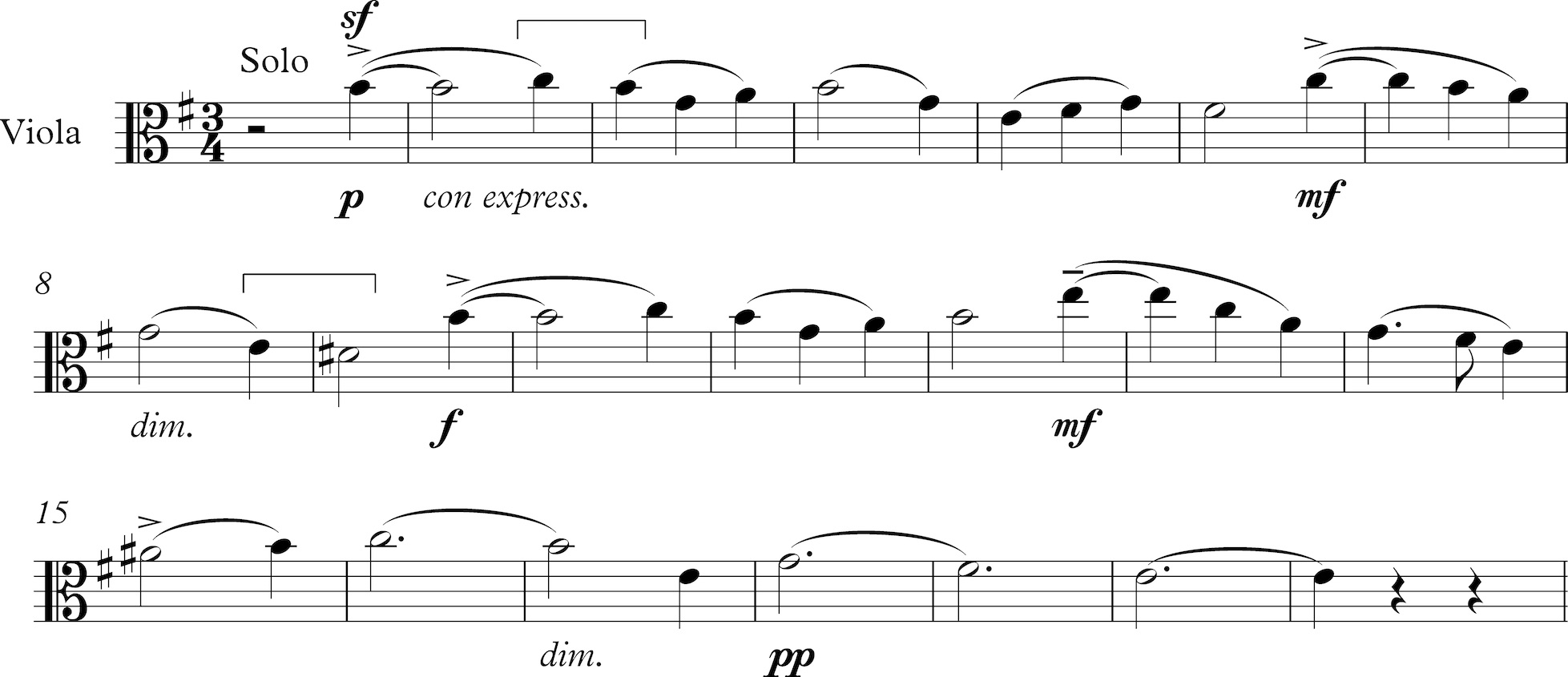
Though the pairing of two half-steps isn’t particularly emphasized in the theme, it is the combination of B-C and E-D# (marked with brackets) that will turn out to be motivically significant for the entire work. This is a Beethovenian motive, of course, and one that played a large role in Beethoven’s late string quartets, which Bristow, as a virtuoso violinist, had probably played at some time. In fact, Beethoven’s Op. 131 Quartet in C# minor, which opens with just that pitch complex (G# B# C# A), has a series of themes determined by how far apart the pairs of half-steps are in their scales. Bristow does something similar with the themes of this symphony, and it seems probable that Op. 131 was a model for him.
The transitional theme that follows at m. 22 begins as seemingly as a lyrical continuation taken over by the violins, but it is interrupted by an Eroica-like motto repeated with 16th-note runs in between, and lending itself to easy modulation.

Here the bass simply descends from E to D to C, bringing the third motto to C major. The passage from mm. 40 to 61 plays around with the main theme motives through diminished seventh chords, finally settling on a long-repeating B-C motive that, at m. 62, finally breaks into the orchestra’s complete statement of the opening theme. None of this material from m. 40 up until m. 111 will be repeated in the recapitulation.
What Bristow does next is unconventional and intriguing. The main theme’s final cadence ends deceptively in C# minor (m. 80). This quickly moves into C# major, in which key he gives an anticipation of the upcoming subordinate theme, though not in its exact form; the phrases that will be the basis for that theme are marked with brackets (and will figure in the last movement as well). And since the subordinate key will be G major, this C# major is as harmonically far away from it as he could get. The second theme will finally appear in G major, then in the development in Bb major/minor, and finally in the recapitulation in E major, so he seemed to feel a need to state it in all four keys of a diminished triad.
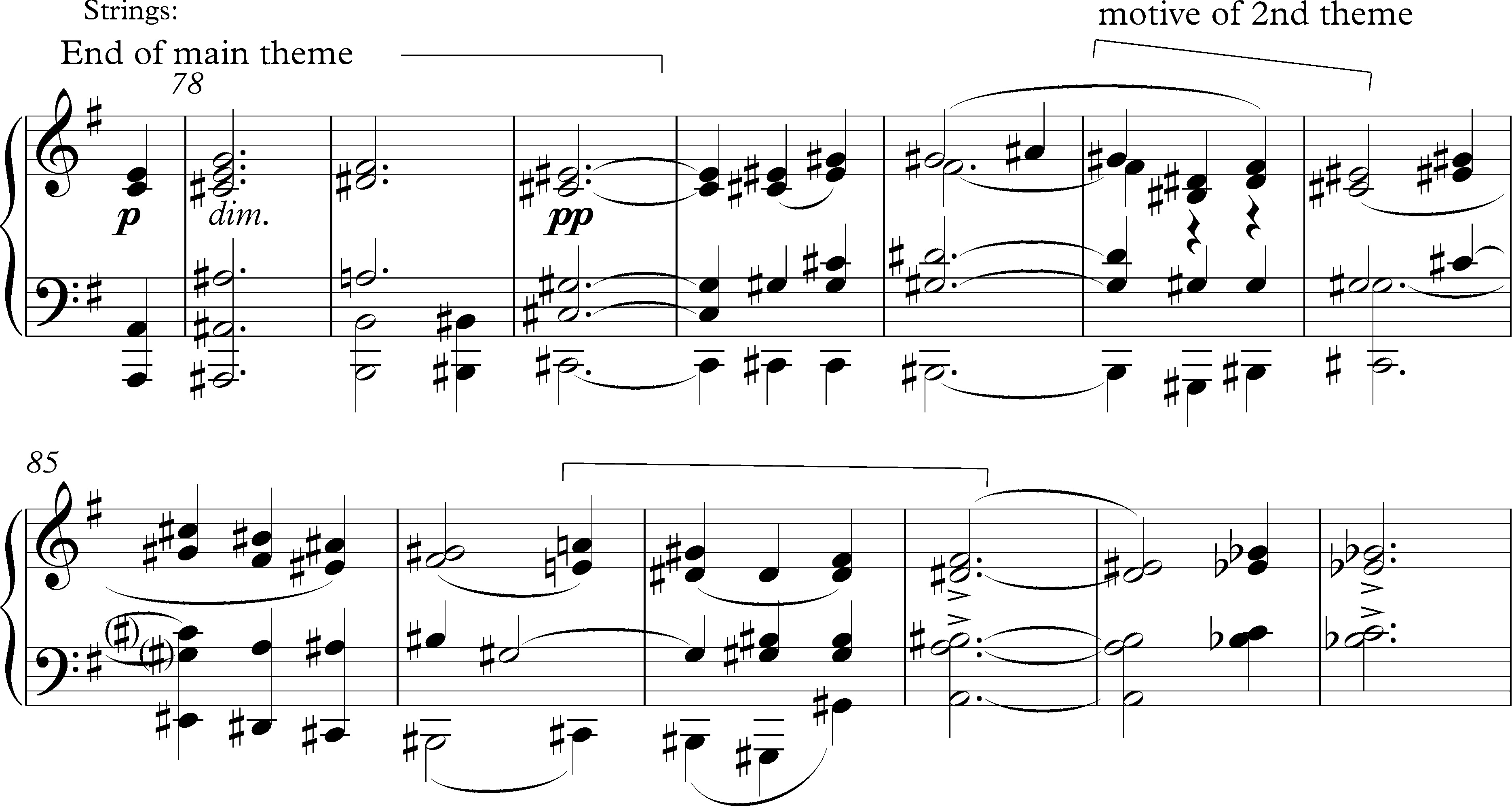
Under the second bracket, one sees the A#-G# and F#-E#, the paired seconds which are the essence of the theme. In this theme the seconds can be either major or minor, but Bristow exits this section via a transition in which the minor seconds of the main theme (transposed to A as A-G# and F-E) are pounded out for emphasis.

At m. 108 we reach material that will reappear in the recap (at m. 596). The music reaches a modulating form of the theme in A minor.

Diminished seventh chords bring us to a D as dominant, through a repeating melodic sequence of half-steps G-F#, Eb-D, and the music pauses after a half-cadence through those four pitches. In mm. 138-150 the winds pause for a leisurely and quiet transition on a D dominant, and in their last measure they are charmingly joined by the strings to introduce the subordinate theme in G major. Notice that the second group of phrases continues the idea of two half-steps (bracketed), C-B and A-G# – only a minor third apart rather than a major third as has been the case up until now.

but it is beautifully inflected between major and minor and keeps generating new but related variations. As the transition to the theme emphasized G-F#-Eb-D, the transition back will fixate on two other half-steps: B-Bb-G-Ab (m. 220ff). The music builds, leaping to ever higher downward step motives, until we reach a grand theme changing from major to minor, whose triadic movement might remind us a little more of the Eroica than of Bristow’s main theme.

From here to measure 287 the music is a climax of sliding diminished seventh chords and arpeggios leading to a dominant preparation for G and several syncopated cadential formulas. At the penultimate moment, m. 280, the music suddenly shifts toward a deceptively fortissimo Eb-major, but lands safely back in G major after its descent.
The development opens moodily (m. 288), as the tonic G turns into the beginning of the main theme in C minor; as it is elaborated the pitches C-B and Ab-G are all that is left of it. Then the orchestra bursts into a phrase from the theme in Ab major, repeating it immediately in G# minor (this passage will reappear).

Diminished chords take us to the key of A major, where the Eroica-like part of the transitional theme recurs at m. 340. A long stream of twice-repeated chords over a D drone (mm. 349-376) decrescendos to quiet, and then the second theme, now in the woodwinds, enters in Bb and then changes to minor, as though the major/minor switching idea is becoming a habit. An extension of the theme in the low strings bring us to the above major/minor version played in Gb and F# (mm. 406-413), and then the closing theme reprised in D (m. 414). This is developed through various harmonies, until from mm. 430 to 446 a long dominant preparation leads us in decrescendo to G.
Except that when we reach that G it is harmonized as an Eb dominant: the change threatened at the end of the exposition now recurs as modulation. Pianissimo sustained take us though Ab major and F minor to Db major as vestiges of the second theme swirl around.
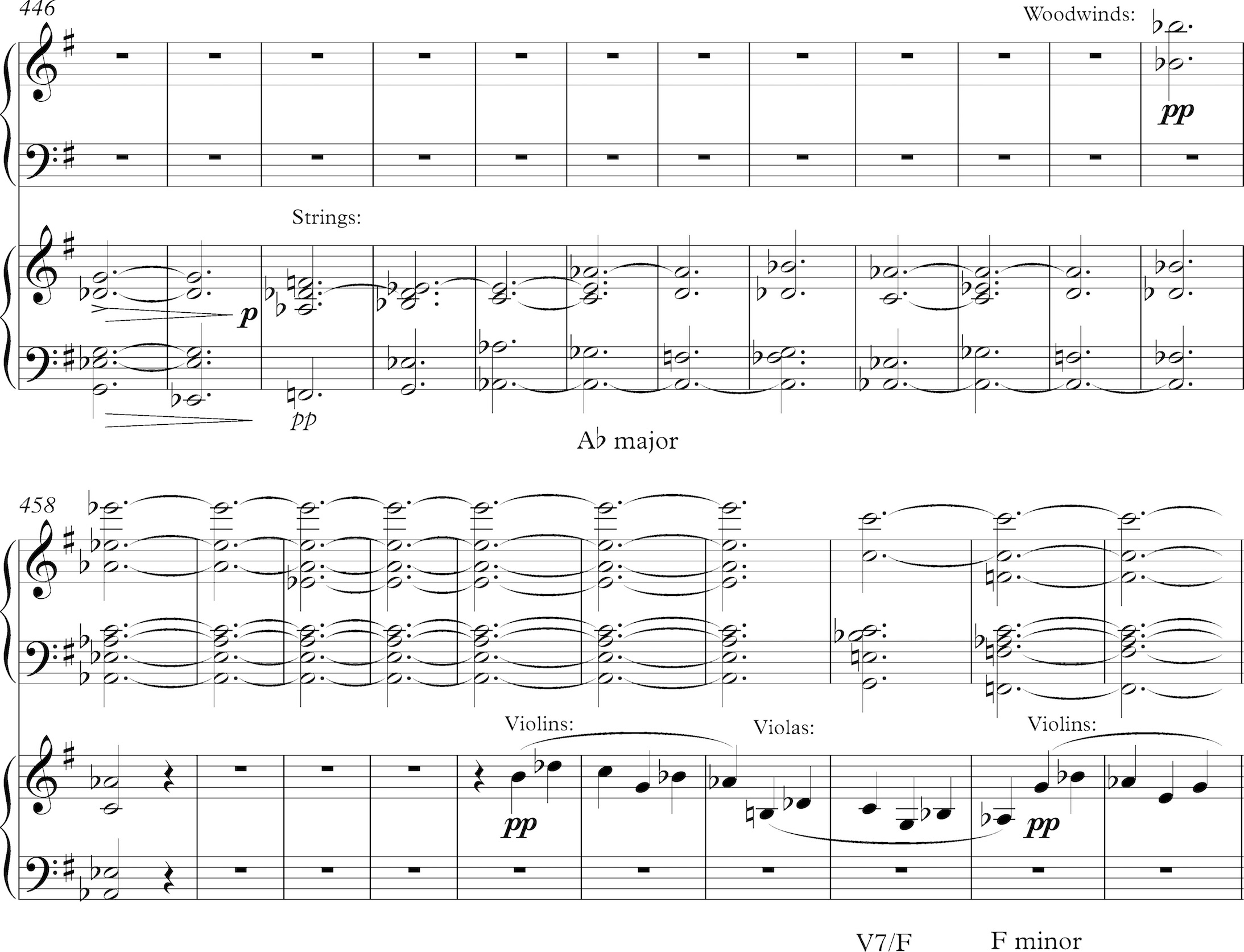
t is Bristow’s habit to change dynamics through long, gradual crescendos and decrescendos, but having lulled us to sleep in a foreign key, for once he indulges, at m. 486, a subito forte on a dominant seventh on A – A7 being the German sixth of Db. The third theme in D returns, but only for a moment, as from mm. 506 to 514 (and this is where the Krueger recording cuts some six minutes) the orchestra slides down a chromatic scale in decrescendo. At m. 517, over a soft B drone, our old pioneer the solo viola enters, for a long time simply playing off-beat dotted-half notes as though calculating whether he’s got it in him to start up the theme again. Meanwhile two clarinets move back and forth between two thirds, just as much of the orchestra did when the strings were mulling over B and C in mm. 51-59; on repeated listenings the repetition is amusing.
With the upbeat to m. 542 the recapitulation officially begins, as the viola restarts the main theme. This time he seems to have family with him, for the strings pluck the off-beats as in an darkly apprehensive waltz. The strings begin the transitional theme (m. 562) a third higher in the scale than before, and by a phrase extension effect an easy modulation to G major for the pounding chords. The exposition and recapitulation can be correlated as follows:
| Mm. | Exposition | Both | Recapitulation | Mm. |
| 1-21 | Main theme (viola) | 541-561 | ||
| 22-39 | Transitional theme | 562-583 | ||
| 40-61 | Main theme motives | |||
| 62-80 | Main theme in orch. | |||
| 81-88 | 2nd theme in c# | |||
| 89-111 | half-step motives | |||
| tutti chords | 584-599 | |||
| 112-138 | Main theme modulating | 600-626 | ||
| 139-149 | Transition to 2nd theme | 627-637 | ||
| 150-203 | 2nd theme | 638-691 | ||
| 204-231 | Transition to climax | 692-715 | ||
| 232-243 | Main theme in maj/min | 716-723 | ||
| New material | 724-795 | |||
| 244-287 | Climax | 796-836 |
The orchestral statement of the main theme is of course omitted from the recap as redundant, nor is the curious anticipation of the subordinate theme in C# brought back, as by now its point has abundantly been made. Instead the recap replaces these with the Eroica-like chords from mm. 350-375 in the development. The modulating form of the main theme comes back in both, and the second theme is restated in the tonic E major. The music crescendos up to the major/minor form of the theme in A, and then Bristow does something remarkable. Instead of waiting until the coda to add some new, freely-composed material, as was classical practice, he goes into seventy-two measures of ecstatic melody containing new ideas not heard earlier.
First there is a joyous C-major melody in thirds as the bass leaps by octaves.

More strangely, the music then quiets down to a harmonically ambiguous trio for flute and clarinets as the cellos rock between B and C (mm. 744-753); and then at m. 754 the violins take off on a leisurely fantasia around motives of the first (and possibly second) themes.
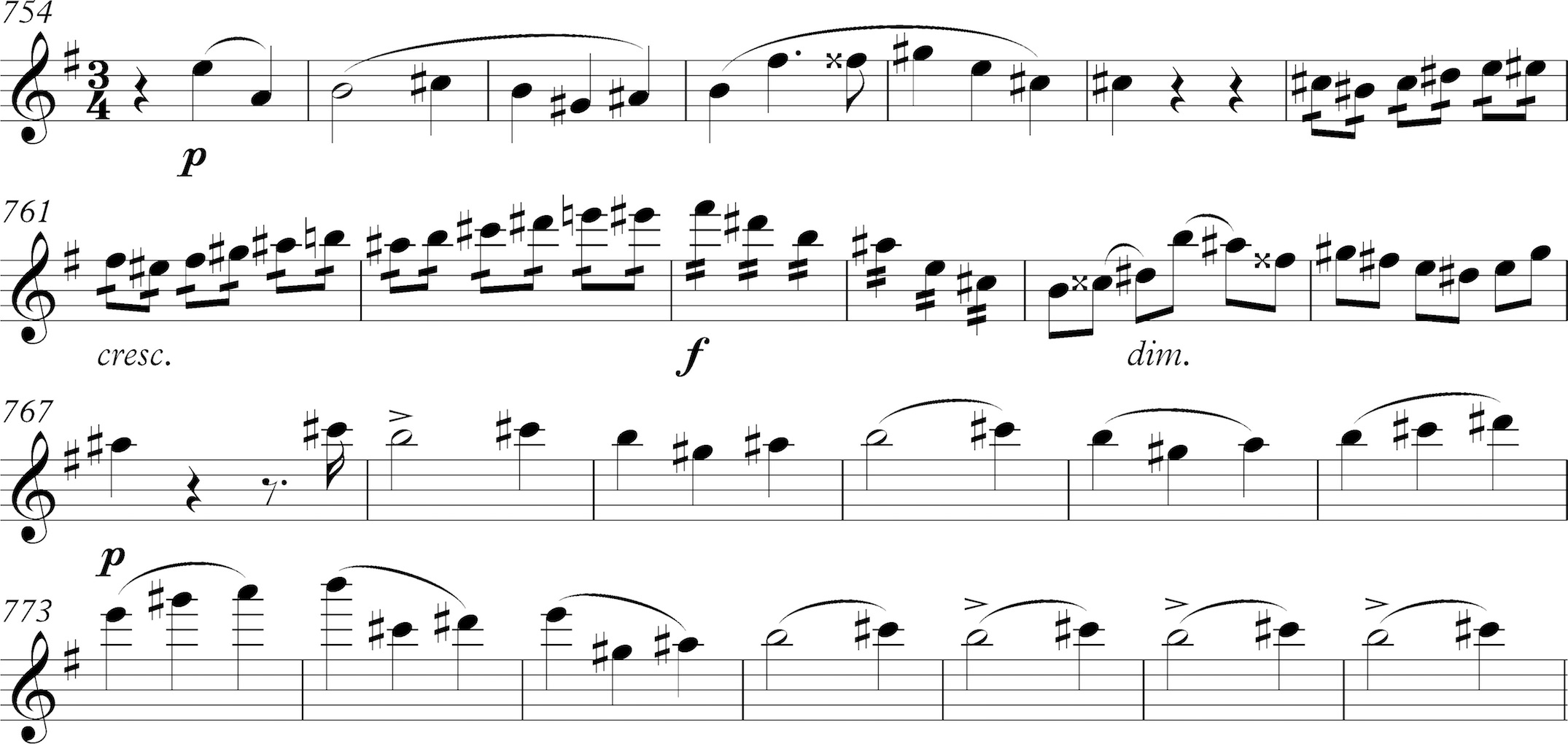
At m. 795 the recapitulation picks up where the exposition was at m. 244 and follows it closely (transposed from G back to E, of course) to m. 836. Where, in the exposition, G major feinted to Eb just before the final cadence, this E major goes to a diminished seventh on A# and stops on it. Once again the solo viola raises his weary bow, to begin the coda on his theme. Bristow is rarely content with simple repetition, though, and this time he inserts a complication, an apparent turn to G# minor at m. 846, that actually stems from the voice-leading to a V/iv. It is an elegant final composerly flourish.
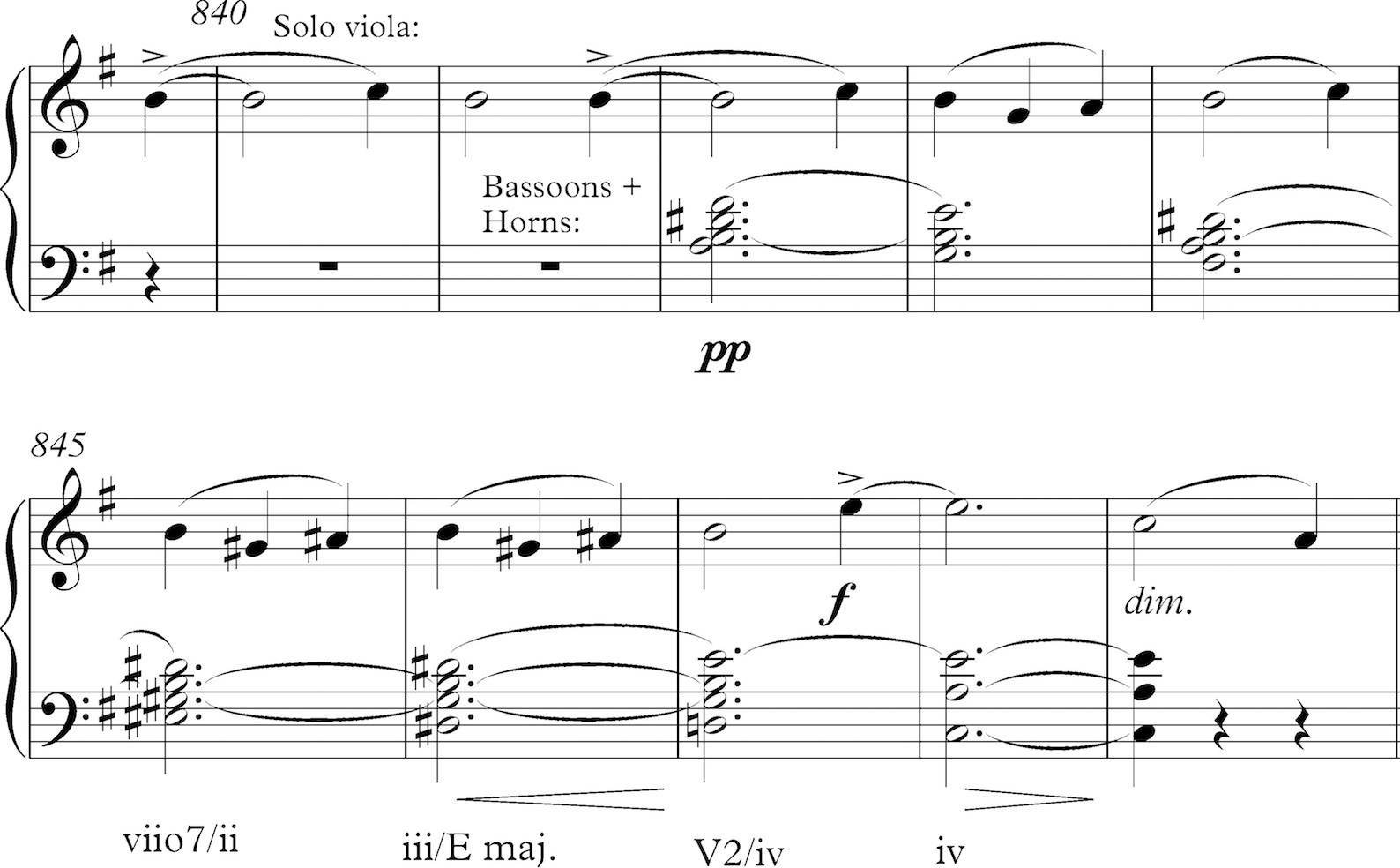
Within the long final E minor chord, the cellos and second violins repeat a lonely phrase of the main theme.
Hear George Frederick Bristow’s Symphony No. 4 in e minor, Op. 50, “Arcadian” below.
Read about George Frederick Bristow here.
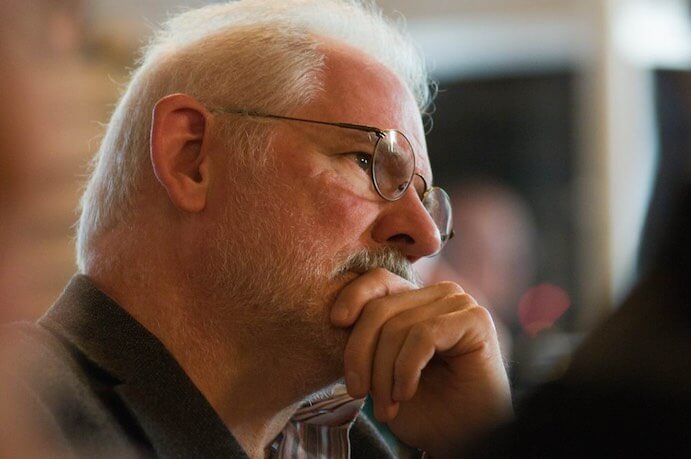 Kyle Gann (b. 1955 in Dallas, Texas) is a composer and was new-music critic for the Village Voice from 1986 to 2005. Since 1997 he has taught at Bard College. He is the author of seven books on American music, including books on Conlon Nancarrow, Robert Ashley, John Cage’s 4’33”, and Charles Ives’s Concord Sonata. He studied composition with Ben Johnston, Morton Feldman, and Peter Gena, and much of his music is microtonal. His major works include the piano concerto Sunken City, Transcendental Sonnets for chorus and orchestra, the microtonal music theater piece Custer and Sitting Bull and The Planets for mixed octet. Visit him at http://www.kylegann.com/.
Kyle Gann (b. 1955 in Dallas, Texas) is a composer and was new-music critic for the Village Voice from 1986 to 2005. Since 1997 he has taught at Bard College. He is the author of seven books on American music, including books on Conlon Nancarrow, Robert Ashley, John Cage’s 4’33”, and Charles Ives’s Concord Sonata. He studied composition with Ben Johnston, Morton Feldman, and Peter Gena, and much of his music is microtonal. His major works include the piano concerto Sunken City, Transcendental Sonnets for chorus and orchestra, the microtonal music theater piece Custer and Sitting Bull and The Planets for mixed octet. Visit him at http://www.kylegann.com/.Category Sight, Sound, Word | Tags:
Comments Off on George Frederick Bristow: Symphony No. 4 in e minor, Op. 50, “Arcadian” (1872) – First movement: Emigrants Journey Across the Plains – An Analysis by Kyle Gann
Sorry, comments are closed.

